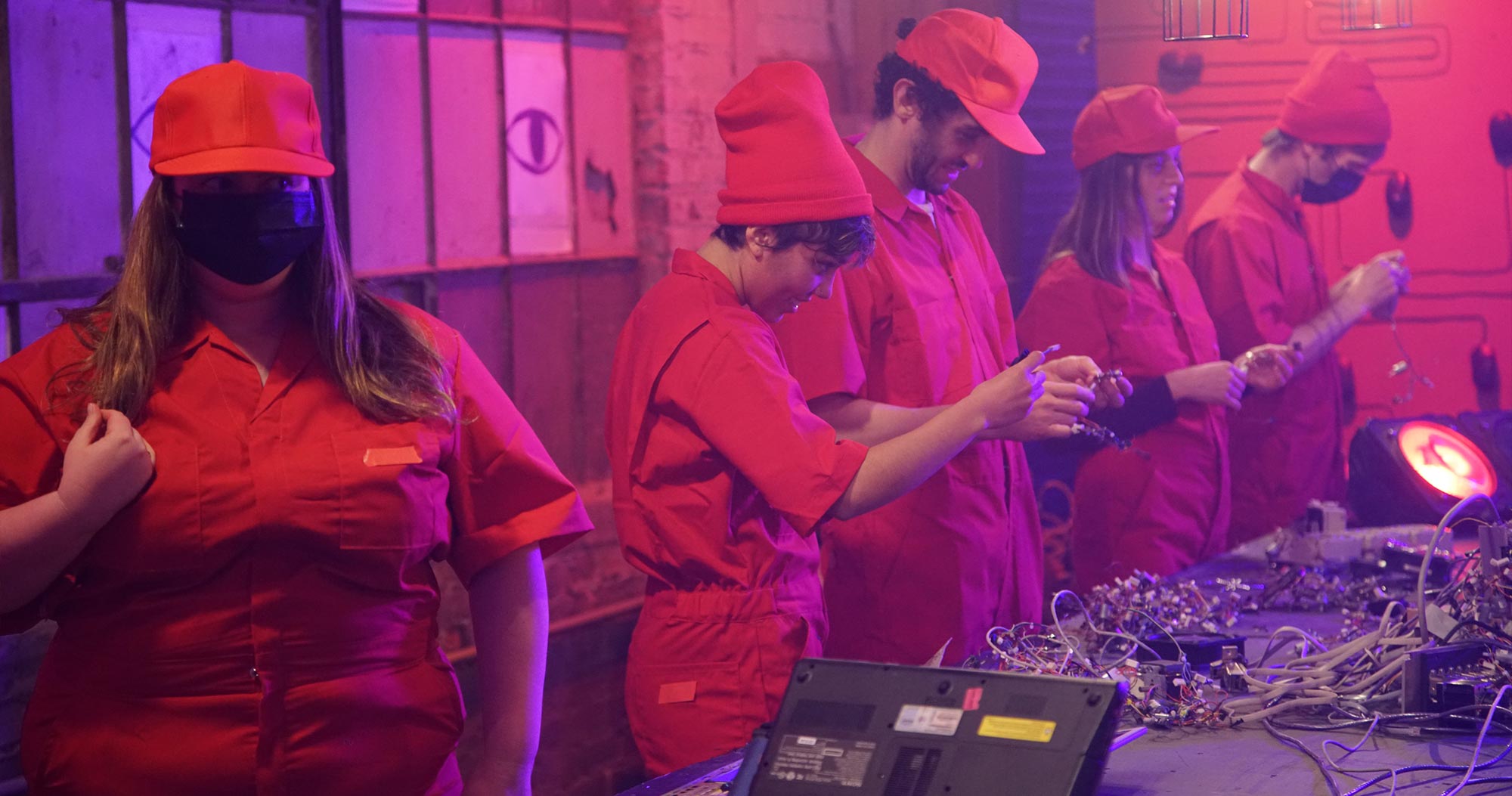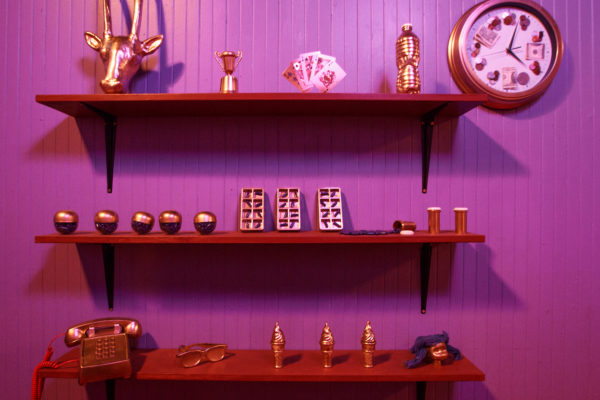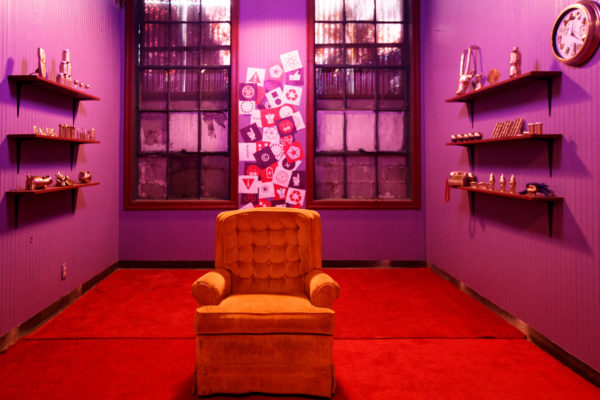The Red World
In the first half of Strangetown, Pancho Morris navigates the dark and twisted underbelly of the capitalist system: The “Red World.” Dive into Pancho’s journey through the world and the inspiration behind each scene from the artists who created them.
The Call
In the mysterious opening to the video, Pancho receives a call from the Red World.

The telephone in the birdcage is the canary in the coal mine. The call on the phone foreshadows trouble ahead. It’s red, just like all of the working class elements of Strangetown. Red phones are also typically used for emergency lines. A crisis is waiting to happen. The phone line is purple. In this film, purple represents the agents of power, such as deep state institutions and the police. The line is being tapped by those in control, those in authority who seek to capitalize off revolution.
The Factory
by Chris Swimmer
Pancho enters the Red World by walking out of a phone booth and into a drab factory. Here, workers on a production line mechanically push gnarled, random electronic components from one side to another to make unknown widgets — all under the watchful eye of a security officer. But Pancho isn’t just taking a stroll through the factory: one of the workers hands him a key.

“The factory is a representation of thoughtless consumerist production and the dehumanizing nature of the production process,” Chris said. “All of the components being “produced” in this scene are actual pieces of e-waste collected from a local e-waste facility. In a society of high consumption, the consumers often forget the dual costs associated with materialism – the human production cost and the cost of the waste produced.”
Chris Swimmer | art@thisischris.com • http://thisischris.com

The Butcher
by Paul Savage
Pancho turns a rather dark corner onto the factory floor of a butchers plant. Here, we see perhaps the most shocking and visceral scene in the Red World, with a second mindless production line showing bloodied workers pounding and sawing away indiscriminately at whatever meat is placed in front of them – animal and human alike. The butcher, with a mad glint in his eye, takes notice of Pancho and laughs maniacally before resuming his gruesome work carving swine with a chainsaw.
The scene is arresting and alarming — a surreal representation of the sadistic and harsh practices we find in the world of the factory farms that feed the masses.
Paul Savage | firesoncreation@gmail.com
The Red Light District
Artwork by Garett Brown & Treigh Love
There’s a homeless person in the alley. Did you notice them? Neither did Pancho. Even good people can become calloused and cold. How accustomed we are to ignoring homelessness.
Having escaped the butcher with his head, Pancho is drawn in by the seedy Red Light District. The streets at the bottom of the Strangetown pyramid are full of trash and graffiti, and it’s here that we hear a woman’s voice. Sex workers beckon to him, and Pancho takes a moment to flirt with them – and with us. The Red Light District represents the commodification of the human body as a service for sale.
But he’s not taken in by the offers. Pancho has somewhere to go: shopping.

Garret Brown | brown.garett@gmail.com
Treigh Love | traydarling@gmail.com • https://treighlove.carbonmade.com
Consumerland
by Ad Naka & Michael Morgenstern
Now entering Consumerland: a bizarre shop marrying fast food, technology and boutique consumerism. In Consumerland, Pancho’s served smartphone sandwiches fresh from the microwave, takes a shot, and is surrounded by over-eager salespeople offering products on a loop.
“Consumerland plays with the connection between a highly derived consumerist economy and the pursuit of happiness,” says vignette lead Ad Naka. “Pancho is served smartphone sandwiches as a commentary on the consumption of technology in our search for instant gratification. The walls of Consumerland housed various gilded objects representing sex, drugs, beauty, gluttony, hedonism, and other vices that have been exploited by industries for profit.”
“Combining the commodification of food, a biological need, with technology, a recent addiction, as well as glorifying the distribution of common products, draws a subtle comparison of how easy it is for corporations to use our wants and needs to make money–and how unavoidable it is for us to play as pawns in their game.”
And in the end, the salespeople win – Pancho chooses a pristine white suit to help him along on the next leg of the journey.
Ad Naka | art@adnaka.com • http://adnaka.com
Michael Morgenstern | michael@everythingiseverything.com • http://everythingisfilm.com
The Protest
Artwork by Garett Brown & Treigh Love
Dressed in his new suit, as people are flooding the scene, Pancho bursts open the back cage of a police van (last seen in the window at McBigley’s, did you catch it?), letting out a hoard of previously captured protestors. Behind them, an Uncle Sam mural, painted by Garett Brown, depicts a powerful figure dangling easy answers, vices, to a fawning populous.
This is the seed of a revolution, the Red World knocking at the guarded gates of the elites and demanding to be seen, heard, and treated as humans.
The protest presents our first clue that something is afoot. The inhabitants of the Red World are not satisfied to work as slave labor, uphold the massive consumerist machine enjoyed by the 1%. They are fighting back. Fighting for change.

Pancho joins the protesters, knocking out a police officer and using the key he smuggled out of the factory to gain entry to the Gold World.
Garret Brown | brown.garett@gmail.com
Treigh Love | traydarling@gmail.com • https://treighlove.carbonmade.com

Find out what happens next, as we deconstruct the “Gold World.”




